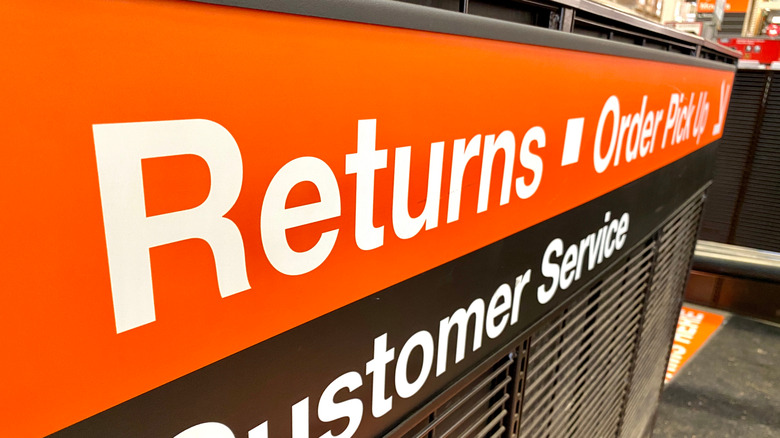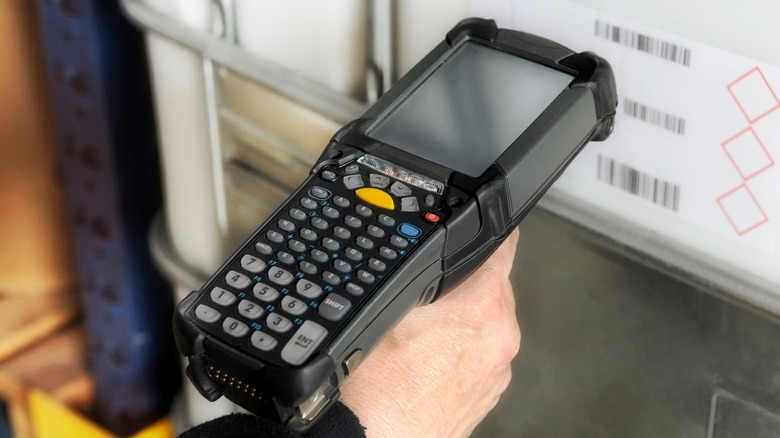How Keeping Your Home Depot Receipts Can Help You Save Money
When it comes to home improvement stores, it's tough to beat Home Depot. It's not only that the home improvement giant sells pretty much any and everything under the sun (from toilet paper to shelving, cleaning supplies to plants, and even snacks), but that they also have some pretty epic policies when it comes to saving you money. (And ultimately keeping their customers happy.)
While Home Depot is relatively lenient if you're looking to exchange or return merchandise without a receipt, it's definitely more beneficial if you have one on your person. That little slip of paper is proof that you're not trying to pull one over on them — not that you would do something like that, though. It also acts as a reference guide for whoever is helping you. In the event that you trashed, ahem, accidentally misplaced your receipt, the Home Depot service desk can possibly print you up a new one if your purchase was in the past 30 days, via Welly Box.
If you're an individual who frequents Home Depot, is always up for a good deal, and is also quite organized when it comes to keeping a record of your purchases, then keep reading for some financially savvy ways to save money with your Home Depot receipts.
There's a very gratuitous return window
According to the home improvement monolith's website, if you're unhappy with your item, and you still have that magical slip of paper that shows you purchased it from their store, you can return it within 90 days for a full refund. This policy works for goods that have been purchased in-store as well as online, which is great because it'll nix that trip to the post office (and having to figure out how to box up whatever challenging-shaped item it is that you're returning).
There are a few items that Home Depot employees will not accept, though. Generators, custom-made products (like flooring or blinds, unless labeled "Guaranteed to Fit"), product samples, and utility trailers are a few of the more obvious ones.
When returning merchandise to Home Depot, it's expected to be in its original packaging and in sellable condition. If you don't have the product box, but the item is still looking sharp, then you shouldn't run into any issues at the return kiosk. Don't expect Home Depot to take back a window air conditioning unit that you purchased mid-summer and are trying to return right before the 90-day return window is up and the weather has cooled down. (Because that's just plain rude.)
They'll honor competitor pricing
Save your receipt, and then save yourself some cash by checking out the Home Depot price matching policy. Price matching is exactly as it sounds. It's when a retail outlet offers to match or undercut the price of a competitor for the same item, via Smart Capital Mind. It's a smart tactic used by other big brand stores like Michael's, Best Buy, Lowes, Target, and Walmart, per The Krazy Coupon Lady. Overall, it helps bring in new customers, builds trust and loyalty in the brand, and gives a nice sales boost. (Because who has ever gone to a store with the intention of using price matching and not come home with more than one thing that wasn't part of the price match?)
The Home Depot price match policy states that if you can prove the item is of equal price to a competitor, they'll knock theirs down to make the sale. This applies to both brick-and-mortar and online sales. According to Consumer Reports, if you purchase an item that goes on sale, or if a competitor has a better deal, they will give you a partial refund as long as you have your receipt and it's within 90 days.
You're going to want to check out those warranties
Home Depot provides warranties that fall into two categories: general merchandise and major appliance plans. General merchandise covers everything that's not a major appliance (even seasonal decorations). Unfortunately, they're not factored into the price of the item you're buying and need to be purchased separately. While this may seem like a bit of a bummer, it's totally worth the extra investment. They also offer extended warranties on some products, too.
All items purchased from Home Depot come with a manufacturer's warranty, which typically provides coverage for any defects or issues that occur from normal product use. So if in the middle of summer, the ice maker in your refrigerator goes kaput and it's still under warranty, then you should be covered (granted you weren't adding ice cubes to try and instigate it to work faster, which might actually burn out the auger motor, per Repair Clinic.)
If your item is defective or has some issue that the manufacturer's warranty does not cover (always read the fine print), the extra Home Depot warranty that you thankfully purchased can cover the replacement parts and in-home repair services. But only if you have a receipt.
Don't forget about rebates
Before you make any significant purchase at Home Depot, first take a moment and check their online rebate center. (And don't forget to put in your proper location, too, or you might fail to find the correct rebates.) A rebate, notes Enable (a rebate management website), is basically a discount or partial refund that can be used toward a product or service after it has been purchased.
You can either mail in your rebate request or enter the information online. In order to claim your money, all you need is your little ol' receipt. If you're planning on mailing in your form, you'll need to make sure that your envelope is postmarked within 30 days of your purchase, per Deals Points. Once the rebate center receives and processes your submission, you can expect your payment in around six to eight weeks. The hitch is that you won't be receiving a check or cash money. You'll receive your credit in the form of a Home Depot gift card. And you can only get rebates on in-store purchases.
They'll help you with your thumb of death
So you've brought home a new addition in the form of some very green and vibrant foliage. After following instructions to a T, somehow your little plant buddy begins to go south. It's a plant parent's worst nightmare. Normally, you'd have to cut your losses and give your little green guy a proper burial in your outdoor compost bin. But if you purchased it from Home Depot, have no fear. They've got a pretty cushy process for "reviving" plants that have gone to meet their maker.
If you happen to be one of those poor individuals who have a thumb of death and you purchase a plant from Home Depot, you're in luck. Query Sprout notes that the company will take back your expired plant within 90 days, as long as you have proof of purchase. This 90-day policy applies mainly to flowering plants and succulents. If you happen to purchase a tree, shrub, tropical plant, or perennial, you've got a good year to task yourself with keeping said foliage alive. But after 365 days, you won't be able to switch it out or get your money back. So make sure to read up on being a good plant nanny.





